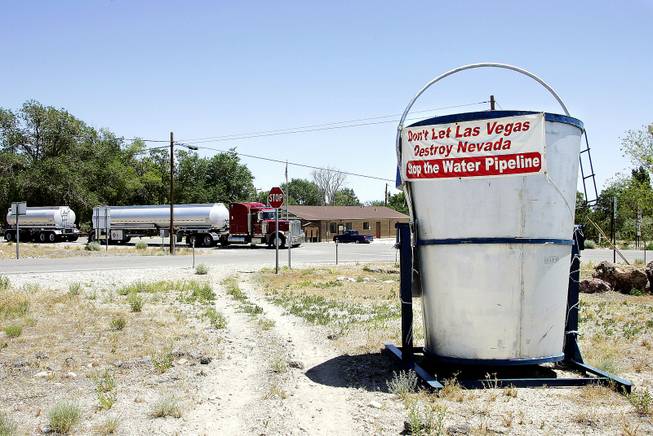
SAM MORRIS / LAS VEGAS SUN FILE
Rural counties’ opposition to the Southern Nevada Water Authority’s pipeline plan has been strong for many years, as this sign in Baker in 2007 shows.
Sunday, Jan. 31, 2010 | 2 a.m.
In Today's Sun
Sun Archives
- Nevada Supreme Court tosses Las Vegas claims to rural water (1-28-2010)
- Nevada Supreme Court to expedite water rights case (1-22-2010)
- Governor delays signing Utah-Nevada water-sharing pact (1-9-2010)
- Supreme Court OKs $4 million water rights settlement (12-14-2009)
- Utah, Nevada draft water agreement (8-13-09)
The Nevada Supreme Court’s ruling last week that upheaved multibillion-dollar plans to tap water from rural Nevada for the Las Vegas Valley has thrown into confusion the fate of a project that was once hailed as essential to the future of Las Vegas.
The ruling jeopardizes two decades of planning to draw water from the Great Basin to sate local needs, by concluding that the applications for water rights coveted by the Southern Nevada Water Authority had long ago expired.
This doesn’t spell the death of the pipeline project. The issue now returns to District Court. And for its part, the Water Authority reacted quickly to the court’s decision by immediately refiling its applications for water rights in eastern Nevada. The agency hopes to eventually have permission to draw water south to Las Vegas via a 300-mile pipeline.
Meanwhile, the door is open for hundreds of pipeline opponents who had been excluded from the process to finally protest the plan, a prospect that seems likely to throw more obstacles in its way.
And it’s possible that this time, the Water Authority won’t get the water.
Maybe it won’t matter.
Some members of the Water Authority’s governing board are no longer convinced the pipeline is needed. For starters, growth has stalled and the dire projections of a burgeoning city going thirsty have lost some of their urgency.
Meanwhile, the Water Authority has poured millions of dollars into a new intake valve at Lake Mead to bring water from lower lake elevations to Las Vegas, for demonstration projects at a desalination plant in Arizona and to store its extra Colorado River water in Arizona.
The Water Authority also is negotiating with Mexico over the construction of a desalination plant there in exchange for Mexico’s share of river water.
Water Authority board member and County Commissioner Steve Sisolak is calling for a new needs assessment, based on new growth projections.

Steve Sisolak
“What’s the point of doing these multibillion-dollar projects if we find out in 30 or 40 years that we don’t need them?” he said.
“I’m very supportive of the Water Authority and my constituents want to know that when they turn on the tap the water is gong to come out, but this is costing a lot of money,” he said. “There have been a lot of costly projects that have come forward. We need to be sensitive to people’s pocketbooks.”
Though the Water Authority has vowed to reapply for all the water rights it believes are in jeopardy and is even contemplating asking the Supreme Court to reconsider its ruling, any action will take time, possibly delaying pipeline construction by years.
It’s a luxury the agency may not have.
The delay comes as the Las Vegas Valley is facing yet another year of uncertain water supply, as snow pack in some parts of the Colorado River Basin, the source of 90 percent of the valley’s water, continues to dwindle. The Bureau of Reclamation predicts the water level at Lake Mead will continue to fall.
The elevation of water in the lake is expected to reach its lowest point in October, when the Bureau of Reclamation predicts it will be about 1,076 feet above sea level.
That is ominous, because when the lake drops to 1,075 feet above sea level, states that draw from the Colorado River will face rationing. In a 2007 contract between the states, brokered by the Interior Department, Nevada agreed to reduce the amount of water it takes from Lake Mead by 13,300 acre-feet a year. That’s enough water to supply 6,650 average Southern Nevada homes at today’s water usage rate.
Elevation 1,075 is also the point where the Water Authority says it will have to begin building its pipeline project. The agency in recent years has contended this option is something of a last resort — and something that wouldn’t be triggered for many years.
But this year’s river-flow projections have made the issue more pressing.
Despite recent storms, the Bureau of Reclamation’s estimates aren’t likely to improve much, bureau staff and climatologists said.
“Unless in the next 10 days it snows a whole lot, I wouldn’t say the lake level projections would look radically different,” said Robert Walsh, a Bureau of Reclamation spokesman. “We’ve had a little impact from the snow and rain that’s occurred in the lower basin ... We could have seen maybe a foot or foot and a half (rise in Lake Mead) over the last four weeks as a result of reduced water orders from agricultural districts, and snow pack did go up in some places, but what that translates into down the road, we’re not sure.”
Climatologists say it won’t likely translate into a heck of a lot of water.
That’s because El Niño years, like this year, are a win-lose scenario for the Colorado River basin. El Niño storms bring heavy winter precipitation across the southern span of the United States and dry, warm winters to the northern span. The Colorado River basin runs through both.
On the southern end, snow pack in the San Juan Mountains in Southern Colorado is at about 110 percent of normal.
But up north, on Utah’s Green River, snow pack is 60 percent to 70 percent of normal. The Green River is the main tributary to the Colorado River and provides 30 percent to 40 percent of its water. Snow pack trouble there generally means water trouble at Lake Mead, unless all the other tributaries get healthy snow pack.
And that’s not happening this year. Snow pack along the river’s other tributaries are at about 70 percent of normal so far this year. And time is running out.
The snow season is about half over and without more strong storms along the river, the year’s annual outlook could still be bad, said Desert Research Institute climatologist Kelly Redmond, who is also deputy director of the Western Regional Climate Center.
“Often in El Niño years, we rely on that southern snow pack to make up for what might not fall in the upper reaches of the Colorado,” Redmond said. “That’s not what we have now and the prospects aren’t great for that situation to change radically in the next few weeks.”

Join the Discussion:
Check this out for a full explanation of our conversion to the LiveFyre commenting system and instructions on how to sign up for an account.
Full comments policy